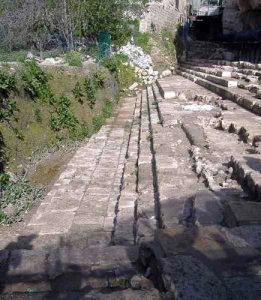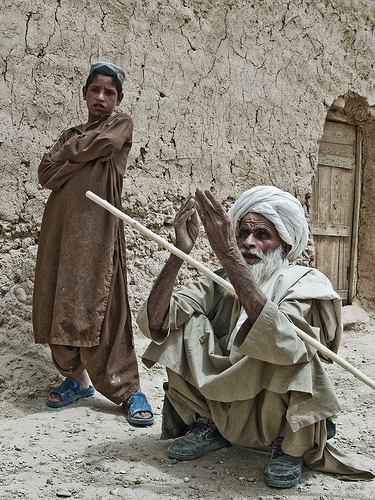Lectionary Reflection
Fourth Sunday in Lent, April 3, 2011
Jesus said, “I came into this world for judgment so that those who do not see may see, and those who do see may become blind.” Some of the Pharisees near him heard this and said to him, “Surely we are not blind, are we?” John 9:39-40
The gospel lesson appointed for this week is the second in a series of long readings that challenge us as Christians to look at who we really are, what we are or are not doing, who Jesus is, and who he is calling us to be. In short, these are what I would call “squirm in your seat” texts. These are wonderful stories of faith and healing and hope and justice, but they also call us to take some long, hard looks at ourselves. We are challenged to assess our faith walk and how we are putting the good news into action 24/7.
Let’s look at the characters in this story. What character would make you least comfortable? Who stretches your imagination and captures your fancy? Can you see yourself identifying with more than one person in the account? Is there any person or group with whom you absolutely know you hold nothing in common?
The role of the blind man I find relatively easy to embrace. On a literal level, my sight is pretty challenged; without glasses the world is a giant blur. Granted, that is a miniscule inconvenience compared with a man who has never seen light, grass, dirt, parents, or home. The aspect of his character I find most challenging is the marginalization. As a North American, I am rich beyond compare even though I probably earn less than most people I know. In fact, according to the Global Rich List, I am among the world’s wealthiest 6%. Even though I grumble about the cost of my healthcare, I can afford to go to the optometrist and purchase new glasses when I need them. There is much about the blind man’s life and place in society to which I cannot lay claim.
 Nevertheless, I find him compelling in the way he responds to Jesus’ healing and grace. First of all, he does exactly what Jesus tells him to–no questions or rationalizations. If someone wanted to put spit and dirt in your eyes, would you be willing, or would you think he was a crackpot? The man is willing to tell his story and not shrink from controversy nor kowtow to the religious elite. Expelled from the synagogue, the man is found by Jesus and confesses his belief. What a powerful testimony and story from an unlikely evangelist.
Nevertheless, I find him compelling in the way he responds to Jesus’ healing and grace. First of all, he does exactly what Jesus tells him to–no questions or rationalizations. If someone wanted to put spit and dirt in your eyes, would you be willing, or would you think he was a crackpot? The man is willing to tell his story and not shrink from controversy nor kowtow to the religious elite. Expelled from the synagogue, the man is found by Jesus and confesses his belief. What a powerful testimony and story from an unlikely evangelist.
We all have faith stories to share, but how often do we do so? I wonder often about the reasons for our lack of zeal in telling why we follow Christ. Is it that we feel our stories are not worthy? Are we afraid of failure? Is it fear of looking stupid or being outside socially accepted norms? Heaven forbid it be merely apathy! Our stories do not have to be Nobel quality in the recounting. The formerly blind man’s most powerful line was “…One thing I do know, that though I was blind, now I see” (vs. 26b). Sharing the good news is not about perfection or eloquence, it is about telling and inviting. Keep it simple and make it plain, but for goodness sake, just do it.
What about the disciples? It seems that they are pretty firmly entrenched in the standard practices and beliefs of their day. Their first question to Jesus is whose sin caused this man to be blind. That’s all we get from them in the story, but it is enough to remind us of how easy it is for us today to fall into standard practices, belief structures, and pet interpretations that cause us to miss the mark and be blind to Jesus’ will and work in the world.
The disciples are not the only ones who miss the mark in the story; the blind man’s own parents are motivated by fear to take a safe path rather than acknowledge the miraculous healing of their son. People who knew him previously as a blind beggar are suspicious of his story and haul him to the authorities. When the man presents them with plain-told truth, they kick him out. Why do we so often allow fear to keep us from fully exercising our faith, and why do we ignore truth when we see it clearly right in front of our own eyes?
![5325707014_94de0f866b[1]](https://www.stewardshipoflife.org/wp-content/uploads/2011/04/5325707014_94de0f866b1-300x200.jpg) Finally, leaders do not get off the hook easily in this story or in real life. The religious elite are hung up on law and right practice and find this healing outside the margins of acceptable behavior. After all, Jesus is involved, and one can’t have that radical stirring the pot! But stir the pot he does, and in the end we the listeners are there to hear Jesus’ response to the good religious folks’ question “Surely we are not blind, are we?” The story ends with these words that call us out and challenge us: “If you were blind, you would not have sin. But now that you say, ‘We see,’ your sin remains.” Ouch!
Finally, leaders do not get off the hook easily in this story or in real life. The religious elite are hung up on law and right practice and find this healing outside the margins of acceptable behavior. After all, Jesus is involved, and one can’t have that radical stirring the pot! But stir the pot he does, and in the end we the listeners are there to hear Jesus’ response to the good religious folks’ question “Surely we are not blind, are we?” The story ends with these words that call us out and challenge us: “If you were blind, you would not have sin. But now that you say, ‘We see,’ your sin remains.” Ouch!
At the end of the lesson and sermon, we are left with the question of blindness and sight. In Jesus we have been given new sight, a grace-full gift. We are given the potential for real vision in our congregations, our communities, and in our homes. Where does our sin remain? How are we being blind to injustice, to need, to mission, to our neighbor? The more important question is what will we do about it?
Visual
If you are using “Amazing Grace” this Sunday, here’s a worship version (Chris Tomlin) with lyrics and beautiful visuals. Another option is Mercy Me’s “Open the Eyes of my Heart, Lord” that you will find here.
With Youth
Consider showing the 2008 movie Blindness (or clips from it), directed by award-winning filmmaker Fernando Meirelles. The story involves citizens stricken with a plague of “white blindness” and how terrifying it is to be the one left seeing in the midst of a societal breakdown. The film will open up many avenues for discussion about real and metaphorical blindness and sight.
With Children
The Visual Bible offers an eight minute clip of this story. One might also take a look at Carol Castenello’s ideas for “Blindness Awareness” in the classroom.
Photos by AfghanistanMatters, Marion Doss and Edward Allen L. Lim used under Creative Commons License. Thanks!




Leave a Reply